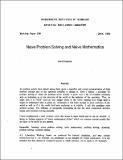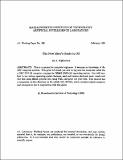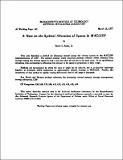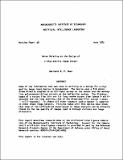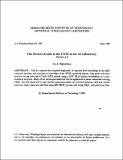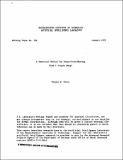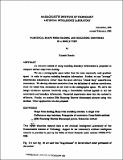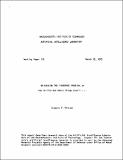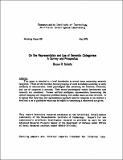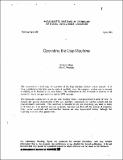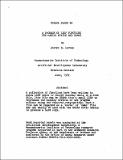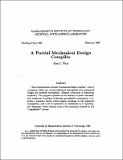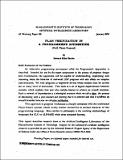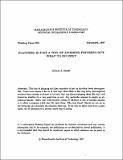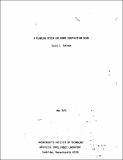Browsing AI Working Papers (1971 - 1995) by Title
Now showing items 159-178 of 291
-
Naive Problem Solving and Naive Mathematics
(MIT Artificial Intelligence Laboratory, 1983-06)AI problem solvers have almost always been given a complete and correct axiomatization of their problem domain and of the operators available to change it. Here I discuss a paradigm for problem solving in which the problem ... -
The New Idiot's Guide to OZ
(MIT Artificial Intelligence Laboratory, 1988-02)This is a manual for complete beginners. It assumes no knowledge of the MIT computer systems. This guide will teach you how to log onto the computer called OZ, a DEC PDP-20 computer running the TWENEX (TOPS-20) operating ... -
A Note on the Optimal Allocation of Spaces in MACLISP
(MIT Artificial Intelligence Laboratory, 1977-03-16)This note describes a method for allocating storage among the various spaces in the MACLISP Implementation of LISP. The optimal strategy which minimizes garbage collector effort allocates free storage among the various ... -
Notes Relating to the Design of a High Quality Image Sensor
(MIT Artificial Intelligence Laboratory, 1975-06)Some of the information that as used in arriving at a design for a high quality image input device is documented. The device uses a PIN photo-diode directly coupled to an FET-input op-amp as the sensor and two moving-iron ... -
The Novice's Guide to the UNIX at the AI Laboratory Version 1.0
(MIT Artificial Intelligence Laboratory, 1988-05)This is a manual for complete beginners. It requires little knowledge of the MIT computer systems, and assumes no knowledge of the UNIX operating system. This guide will show you how to log onto the AI Lab's SUN system ... -
A Numerical Method for Shape-From-Shading From A Single Image
(MIT Artificial Intelligence Laboratory, 1979-01)The shape of an object can be determined from the shading in a single image by solving a first-order, non-linear partial differential equation. The method of characteristics can be used to do this, but it suffers from a ... -
Numerical Shape from Shading and Occluding Contours in a Single View
(MIT Artificial Intelligence Laboratory, 1979-11)An iterative method of using occluding boundary information is proposed to compute surface slope from shading. We use a stereographic space rather than the more commonly used gradient space in order to express occluding ... -
The Object Partition Problem
(MIT Artificial Intelligence Laboratory, 1971-02) -
On Solving The Findspace Problem, or How to Find Out Where Things Aren't ....
(MIT Artificial Intelligence Laboratory, 1973-03-29) -
On the Representation and Use of Semantic Categories: A Survey and Prospectus
(MIT Artificial Intelligence Laboratory, 1976-05)This paper is intended as a brief introduction to several issues concerning semantic categories. These are the everyday, factual groupings of world knowledge according to some similarity in characteristics. Some psychological ... -
One System for Two Tasks: A Commonsense Algorithm Memory that Solves Problems and Comprehends Language
(MIT Artificial Intelligence Laboratory, 1975-11)Plan synthesis and language comprehension, or more generally, the act of discovering how one perception relates to others, are two sides of the same coin, because they both rely on a knowledge of cause and effect - algorithmic ... -
Operating the Lisp Machine
(MIT Artificial Intelligence Laboratory, 1981-04)This document is a draft copy of a portion of the Lisp Machine window system manual. It is being published in this form now to make it available, since the complete window system manual is unlikely to be finished in the ... -
A Package of LISP Functions for Making Movies and Demos
(MIT Artificial Intelligence Laboratory, 1972-06)A collection of functions have been written to allow LISP users to record display calls in a disk file. This file can be UREAD into a small LISP to reproduce the display effects of the program without doing the required ... -
Parallel Flow Graph Matching for Automated Program Recognition
(MIT Artificial Intelligence Laboratory, 1988-07)A flow graph matching algorithm has been implemented on the Connection Machine which employs parallel techniques to allow efficient subgraph matching. By constructing many different matchings in parallel, the algorithm is ... -
A Partial Mechanical Design Compiler
(MIT Artificial Intelligence Laboratory, 1987-02)I have implemented a simple "mechanical design compiler", that is a program which can convert high-level descriptions of a mechanical design into detail descriptions. (Human interaction is sometimes required.) The program ... -
Plan Recognition in a Programmer's Apprentice
(MIT Artificial Intelligence Laboratory, 1977-05)Brief Statement of the Problem: Stated most generally, the proposed research is concerned with understanding and representing the teleological structure of engineered devices. More specifically, I propose to study the ... -
Plan Verification in a Programmer's Apprentice
(MIT Artificial Intelligence Laboratory, 1978-01)Brief Statement of the Problem: An interactive programming environment called the Programmer's Apprentice is described. Intended for use by the expert programmer in the process of program design and maintenance, the ... -
Planning is Just a Way of Avoiding Figuring Out What To Do Next
(MIT Artificial Intelligence Laboratory, 1987-09)The idea of planning and plan execution is just an intuition based decomposition. There is no reason it has to be that way. Most likely in the long term, real empirical evidence from systems we know to be built that way ... -
A Planning System for Robot Construction Tasks
(MIT Artificial Intelligence Laboratory, 1973-05)This paper describes BUILD, a computer program which generates plans for building specified structures out of simple objects such as toy blocks. A powerful heuristic control structure enables BUILD to use a number of ... -
The Position of the Sun
(MIT Artificial Intelligence Laboratory, 1978-03)The appearance of a surface depends dramatically on how it is illuminated. In order to interpret properly satellite and aerial imagery, it is necessary to know the position of the sun in the sky. This is particularly ...

